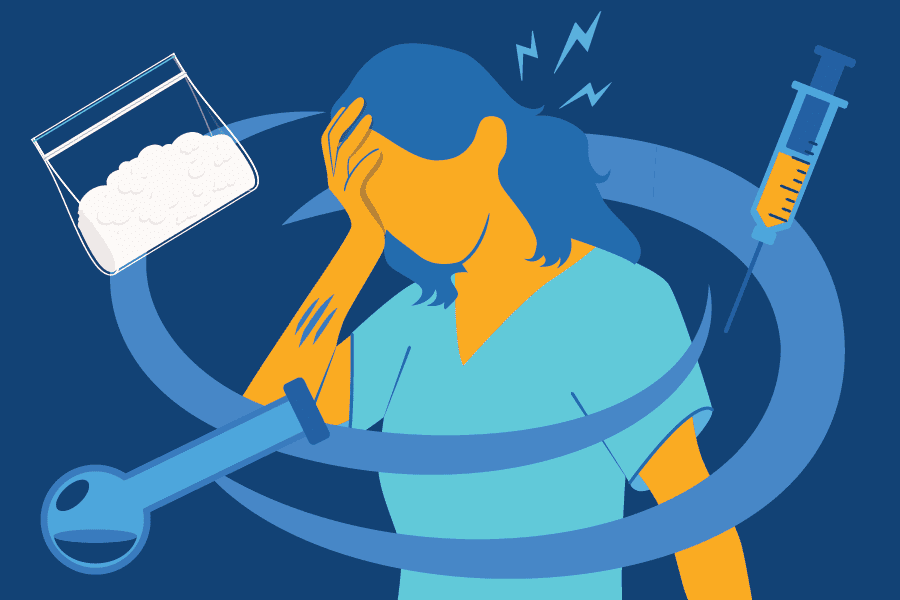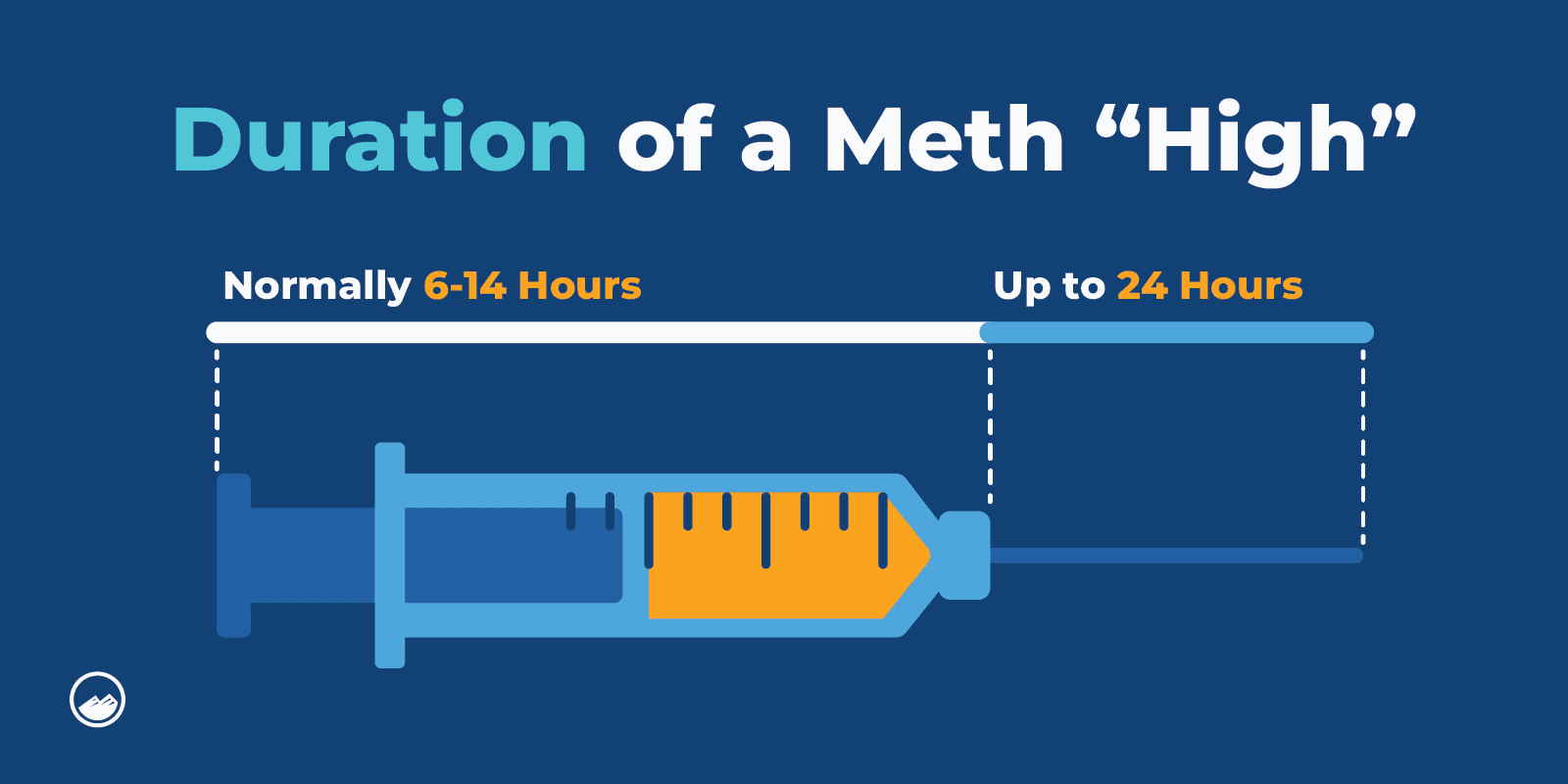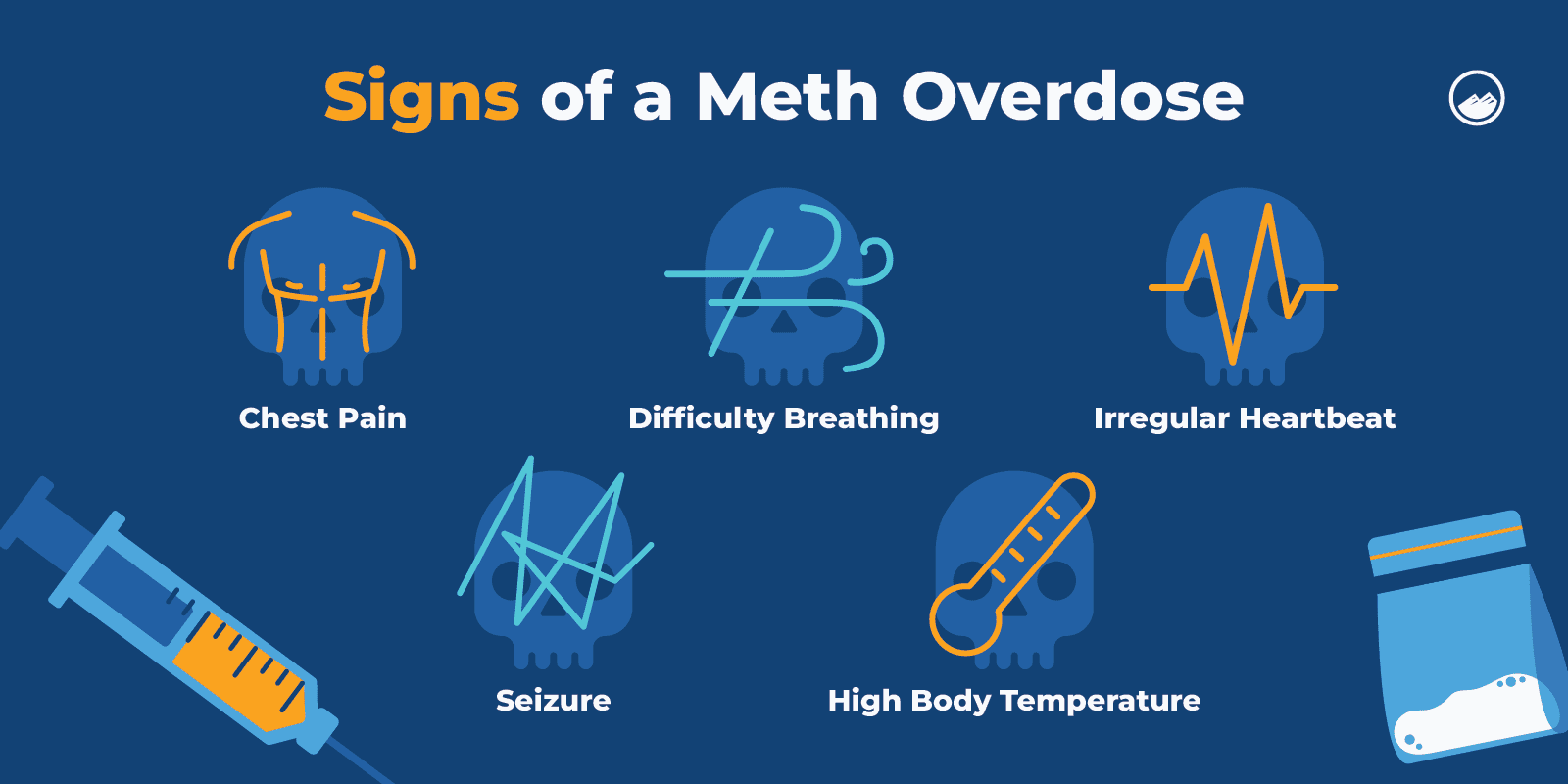Meth Symptoms: 15+ Use & Meth Withdrawal Symptoms


Methamphetamine, also known as meth, is a highly addictive synthetic stimulant.

Meth is a central nervous stimulant that creates an intense sensation, or rush, when taken.
It releases very high levels of the neurotransmitter, dopamine, which creates feelings of pleasure which makes individuals who use methamphetamine continuously seek it out and become addicted quickly.
Meth has serious effects on both the brain and body. If you or a loved one are facing challenges with methamphetamine abuse, reach out for help as soon as possible.
Methamphetamine use can cause a person to temporarily feel euphoric, highly alert, and energized.
The release of “feel-good chemicals” like dopamine, plays a role in the reinforcement of rewarding behaviors. When dopamine is released after a person uses meth, it causes them to experience these heightened feelings and makes them want to use it over and over again.
However, symptoms of meth addiction can also cause aggression, anxiety, paranoia, and other mood disturbances that can be extremely distressing and dangerous.

These symptoms can also combine with symptoms of existing mental illnesses to create even more dramatic mood swings and behavioral health issues.
When a person uses meth, even in small amounts, it can cause serious harmful effects that can include:
Meth can also lead to the development of mental health disorders, impact interpersonal relationships, and harm a person’s physical and mental health and well-being.
The length of time it takes for meth side effects to wear off depends on a variety of different factors.
These factors can include things like:
Generally, a high from meth can last anywhere from 6 hours to 14 hours. Some suggest that the high from meth can last even longer than 14 hours and even up to 24 hours – especially in users with a high number of risk factors.

Methamphetamine is an extremely strong drug, which also means it can lead to overdose.
Overdosing on meth is extremely dangerous and in some cases, fatal.
If you believe someone is overdosing on meth, call 911 immediately and get help.
Some of the most common symptoms of meth overdose can include:
If you believe someone is experiencing a meth overdose, call 911 immediately.

Methamphetamine psychosis can occur as a result of heavy meth use.
Two of the main symptoms of meth psychosis include paranoia and hallucinations.
This can cause them to:
Due to meth psychosis, a person may exhibit aggressive, erratic, or violent behaviors.
Symptoms of methamphetamine psychosis commonly last between two to three hours.
However, in more severe cases, meth psychosis symptoms can last for days or even months.
Hallucinations involve seeing, hearing, or feeling things that are not real.
A person who abuses meth may hear voices that are not there or see people who do not exist. They may also feel that bugs are crawling all over them when they are not.
The effects of meth addiction can lead to hallucinations and delusions.

Common signs of meth addiction can include:
When meth is being made, it can have a very unusual smell similar to ammonia.
If meth is being smoked, it can have a light, subtle, and sometimes sweet smell.

On top of the signs of meth substance use disorders, physical changes and signs of meth use can include:
A person using meth can also be unpredictable, aggressive, or violent. They may also experience anhedonia – which means they struggle to experience pleasure or become motivated.
Meth mites, also known as meth bugs, ice mites, or crank bugs, are terms used to describe the imaginary bugs that a person using meth might feel on their skin.

When meth users feel these imaginary bugs on their skin, it can be so distressing that they intensely pick or scratch at their skin to relieve the sensation.
Meth mites can cause meth sores all over the body due to scratching and picking.
These can look like pieces of raw skin, scratches, scabs, or sores.
Meth sores occur when a person uses meth scratches and picks their skin.
These commonly occur on the face but can also occur all over the body like on the arms, chest, and legs.
A person using meth commonly scratches or picks at their skin because they might hallucinate and feel bugs crawling all over them.
Constantly scratching and picking at their skin can cause open sores that put a person at higher risk of long-term effects such as infection.
Meth can also be present in a person’s sweat, and when it seeps through the pores in their skin. This can cause damage to the skin and also lead to skin sores.

Meth sores can be different from person to person, but they often look like small, open scabs or wounds.
They can also appear as red and inflamed skin due to constant scratching.
Oftentimes, sores can become scabs and form crusts that also increase the risk of infection.
Meth mouth involves serious tooth decay and gum disease due to the use of methamphetamine.
The effects caused by methamphetamine use can also lead teeth to break or fall out.
A variety of factors can contribute to the development of meth mouth.
Over time, meth use can deteriorate the health of your brain and body, including your mouth.
Meth can lead to dry mouth which decreases the production of saliva. Dry mouth creates an environment where bacteria increases.
With methamphetamine addiction, individual also often become preoccupied with meth use, that they neglect daily responsibilites and self-care, including things like brushing their teeth or properly taking care of their hygeine.
Another factor that can contribute to meth mouth is that meth contains acidic compunds which can lead to the deterioration of teeth.

Meth mouth can cause blackening, staining, rotting, or falling out of teeth.
An indivdiual with meth mouth might be missing teeth or have rotting teeth.
Meth can have a severe impact on the brain, especially when used over time.
Methamphetamine is considered to be a highly addictive drug. When a person uses methamphetamine, even in small amounts, they can build a tolerance which means that a person will take more and more of it to achieve the same pleasurable effects.
When a person becomes dependent on methamphetamine, they will experience withdrawal symptoms that occur as the body and brain react to the individual stopping the drug.
In addiction, meth can cause psychotic symptoms such as paranoia, visual and auditory hallucinations, and delusions.
Research shows that meth can alter brain structures that are involved in important functions such as decision-making.
Studies also show that methamphetamine use causes changes in areas of the brain that have to do with emotion and memory which can lead to emotional and cognitive issues.
Fortunately, some of the effects on the brain from methamphetamine seem to be partially reversible with proper care, treatment programs, and abstinence from methamphetamine.
This is one of the reasons why it is so important to seek help as soon as you can if you or a loved one are facing challenges with methamphetamine use.
Studies show that methamphetamine can affect the brain’s dopamine systems.
Dopamine is an important brain chemical that is responsible for pleasure, satisfaction, and motivation. It also plays a big role in other important functions such as memory, mood, learning, and concentration.
Methamphetamine abuse has also been shown to have an impact on microglial cells in the brain which work by protecting the brain from infectious agents and removing unhealthy neurons. Meth abuse can cause too much activity of these cells which can cause them to attack healthy neurons.
Withdrawal symptoms occur when a person has developed a dependence on meth. When an individual stops using methamphetamine, their brain and body respond to the absence of the drug which can lead to severe, and in some cases, life-threatening symptoms.
The effects of withdrawal can include:

Having a strong support system can help a person manage meth cravings and other challenges that come when a person is trying to recover from substance abuse and addiction.
Going to therapy can help a person talk through these cravings and find ways to cope or manage their systems.
For example, cognitive behavioral therapy (CBT) is a common form of psychotherapy that helps a person identify and change unhelpful thought patterns and behaviors.
Medication-assisted treatment (MAT) is also an approach that can be used that combines medication with behavioral therapies to help treat substance use and co-occurring disorders.
Practicing self-care is also important for your mental health and overall well-being. Taking care of yourself is an important part of healing and can help you avoid or manage cravings healthily.
Other techniques to manage cravings can also include mindfulness and meditation. Mindfulness involves being present in the moment and working on awareness.
Being aware can help a person recognize when their body or brain is experiencing cravings and decide what steps they want to take to manage their cravings.
Meditation helps a person find peace and calmness in their everyday lives. Sometimes, cravings can occur when a person is under a lot of stress. Practicing meditation can help a person reduce the stress in their lives and decrease the affect cravings have on them.
The length of time methamphetamine stays in your system depends on a variety of different factors.
The effects of meth typically last for around 8 to 24 hours.
Certain factors that can affect how long a person feels the effects of meth and how long it stays in your system can include:
Meth has a half-life of 9 to 24 hours which represents the amount of time it takes for the amount of methamphetamine in a person’s blood to cut down by half.
Additionally, methamphetamine can still be detected in the body months after a person’s last use, depending on the way it is being tested.
For example, urine tests can detect meth for up to 72 hours. A hair test can detect meth for up to 90 days after last use.
If a person has a methamphetamine use disorder, it is important not to suddenly stop taking it on your own as withdrawal effects can be severe and in some cases, life-threatening.

To get meth out of your system, reach out for professional help to a health care provider or addiction treatment center that can provide the proper care for a person trying to get help for methamphetamine addiction.
A medically supervised detox provides a safe space where a person can rid their body of a drug while having proper support, care, and supervision.
Meth withdrawal can lead to severe symptoms and in some cases, be life-threatening.
This is one of the reasons why it is important to not try and detox at home or on your own.
Some of the serious symptoms associated with meth withdrawal include anxiety, paranoia, aggression, psychosis, and suicidal thoughts.
If you or a loved one are experiencing suicidal thoughts, seek help immediately and call 911, or call the National Suicide Prevention Lifeline at 988.
Another serious risk of meth use is overdose. Overdose from meth can cause serious, fatal effects including heart attack, cardiac arrest, seizure, and stroke.
The meth withdrawal timeline can be very different for each individual.
A variety of different factors can impact a person’s withdrawal timeline, including:
Acute withdrawal symptoms from meth typically occur within 24 hours after their last use and commonly last between 7 to 14 days.
Protracted withdrawal is when withdrawal lasts longer than acute withdrawal, which is typically an extra 2 to 3 weeks.
It’s important to note that while physical withdrawal has a standard timeline, mental effects such as post-traumatic stress disorder that may be caused by the events of meth addiction can take much longer to recover from.
FAQ
Our goal is to provide the most helpful information. Please reach out to us if you have any additional questions. We are here to help in any way we can.
Individuals with Attention-Deficit / Hyperactivity Disorder (ADHD) can experience different effects from drugs because their brains might be more sensitive to it’s effects.
For example, they might feel the affects of methamphetamine more quickly than someone who doesn’t have ADHD, or become addicted faster.
Opioids refer to a class of drugs that interact with opioid-receptors on both the brain and body.
Some examples of opioids include fentanyl, oxycodone, hydrocodone, morphine, and codeine.
Methamphetamine is not considered an opioid and is considered a stimulant.
Stimulants include nicotine, amphetamines, and cocaine.
More specifically, meth is a central nervous system stimulant which creates a very intense sensation, or “rush”.
Meth can be administered and abused in different ways.
It may be smoked, snorted, injected, or swallowed.
If you are concerned about a loved one using meth, some warning signs of meth paraphernalia in their home you can look out for may include:
Additionally, methamphetamine can come in a variety of different forms but is often found as a pill or powder. Crystal meth looks like glass fragments that look like shiny blue and white rocks.
Methamphetamine use can lead to a stroke due to a variety of different reasons.
A stroke from meth use may be caused by elevation in blood pressure, vasculitis, or other vascular toxicity, according to research.
Meth-caused strokes are also more likely in people who have a family history of strokes.
If a person experiences a stroke from meth use, it can result in death, which is why it is so important to get help as soon as possible if someone is facing challenges with methamphetamine use.


Methamphetamine, also known as meth, is a highly addictive stimulant that can cause severe symptoms and in some cases, become life-threatening. Sandstone Care is here to support teens and young adults with mental health and substance use disorders.